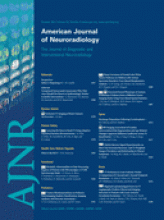Research ArticleSpine Imaging and Spine Image-Guided Interventions
Open Access
Pedicle Marrow Signal Hyperintensity on Short Tau Inversion Recovery- and T2-Weighted Images: Prevalence and Relationship to Clinical Symptoms
B. Borg, M.T. Modic, N. Obuchowski and G. Cheah
American Journal of Neuroradiology October 2011, 32 (9) 1624-1631; DOI: https://doi.org/10.3174/ajnr.A2588
B. Borg
M.T. Modic
N. Obuchowski

References
- 1.↵
- Ulmer JL,
- Elster AD,
- Mathews VP,
- et al
- 2.↵
- Ulmer JL,
- Mathews VP,
- Elster AD,
- et al
- 3.↵
- Hollenberg GM,
- Beattie PF,
- Meyers SP,
- et al
- 4.↵
- 5.↵
- Sairyo K,
- Katoh S,
- Takata Y,
- et al
- 6.↵
- Modic MT,
- Steinberg PM,
- Ross JS,
- et al
- 7.↵
- Rahme R,
- Moussa R
- 8.↵
- Modic MT,
- Obuchowski NA,
- Ross JS,
- et al
- 9.↵
- Sairyo K,
- Katoh S,
- Takata Y,
- et al
- 10.↵
- Arendt EA,
- Griffiths HJ
- 11.↵
- Lee JC,
- Malara FA,
- Wood T,
- et al
- 12.↵
- 13.↵
- Schweitzer ME,
- White LM
- 14.↵
- Fredericson M,
- Bergman AG,
- Hoffman KL,
- et al
- 15.↵
- Mitra D,
- Cassar-Pullicino VN,
- McCall IW
- 16.↵
- 17.↵
- 18.↵
- Toyone T,
- Takahashi K,
- Kitahara H,
- et al
- 19.↵
- Kuisma M,
- Karppinen J,
- Niinimaki J,
- et al
- 20.↵
- Albert HB,
- Manniche C
- 21.↵
- Ross JS,
- Zepp R,
- Modic MT
- 22.↵
- Masaryk TJ,
- Boumphrey F,
- Modic MT,
- et al
- 23.↵
- Lang P,
- Chafetz N,
- Genant HK,
- et al
- 24.↵
- 25.↵
- Chataigner H,
- Onimus M,
- Polette A
- 26.↵
- Esposito P,
- Pinheiro-Franco JL,
- Froelich S,
- et al
- 27.↵
- Chamay A,
- Tschantz P
- 28.↵
- Carter D
- 29.↵
- Roub LW,
- Gumerman LW,
- Hanley EN,
- et al
- 30.↵
- Daffner RH,
- Pavlov H
- 31.↵
- Mink JH,
- Deutsch AL
- 32.↵
- 33.↵
- Lakadamyali H,
- Tarhan NC,
- Cakir B,
- et al
- 34.↵
- 35.↵
- Sakai T,
- Sairyo K,
- Mima S,
- et al
In this issue
Advertisement
B. Borg, M.T. Modic, N. Obuchowski, G. Cheah
Pedicle Marrow Signal Hyperintensity on Short Tau Inversion Recovery- and T2-Weighted Images: Prevalence and Relationship to Clinical Symptoms
American Journal of Neuroradiology Oct 2011, 32 (9) 1624-1631; DOI: 10.3174/ajnr.A2588
0 Responses
Jump to section
Related Articles
Cited By...
- No citing articles found.
This article has not yet been cited by articles in journals that are participating in Crossref Cited-by Linking.
More in this TOC Section
Similar Articles
Advertisement











